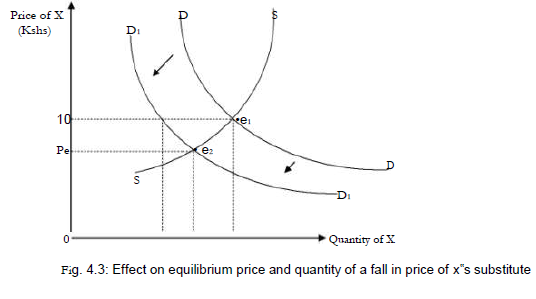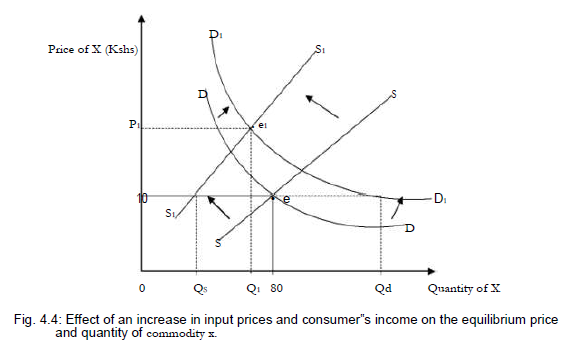1. Substitutes being alternatives in consumption, a fall in price of x?s substitute reduces the
demand for commodity x, represented by a downward shift of the demand curve as shown below:

A fall in price of x?s substitute reduces the demand for x from 80 to Qe units represented
by the downward shift of the demand curve from DD to D1D1 and the movement along the supply
curve from the equilibrium point e1 to e2. Effectively, there occurs excess supply (surplus) over
demand equivalent to (80 - Qd) units at the original equilibrium price of Sh.10. This surplus creates a
downward pressure on price to fall which again discourages suppliers who then supply less of x,
eventually establishing a new equilibrium point e 2 with a fall in equilibrium price from Sh.10 to Sh.Pe and equilibrium quantity from 80 to Qe units of x.
2. A simultaneous increase in input prices and a rise in consumer's income, assuming that
x and its substitute are normal goods: An increase in input prices (being a condition of supply) will lead to a rise in production cost of commodity x, causing its supply to fall - represented by a leftward shift of the supply curve.
An increase in consumer?s income (being a condition of demand) increases the demand
for x due to increase in purchasing power (real income of the consumer) - denoted by an upward
shift of the demand curve.
Overall, the equilibrium price of x will no doubt increase (above Sh.10) but whether the equilibrium
quantity will increase, decrease or remain constant depends on the magnitudes of increase in input
prices and consumer?s income. In theory, three cases are in perspective:
a) Case one: where the magnitude of increase in input prices exceeds that of increase in
consumer?s income, the equilibrium quantity of x falls below 80 units.?
b) Case two: where the magnitude of increase in consumer?s income exceeds that of
increase in input prices, equilibrium quantity increases beyond 80 units of x.?
c) Case three: where the magnitudes are the same/equal then, ideally, the equilibrium quantity remains
constant at 80 units of x.?
However, since the direction of change in price is NOT in doubt (that is, it has to increase) and assuming
the normality of good x and rationality of the consumer, equilibrium quantity would fall below 80 units of x
(case one) as illustrated below:

Wilfykil answered the question on
February 4, 2019 at 11:25